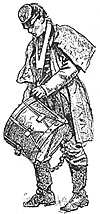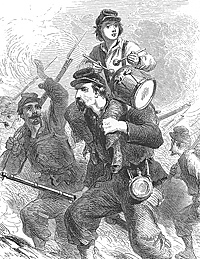(While cleaning out the MagWeb.com office, I came across a series of notes taken in 1998 of a lecture given at the Gen. George Taylor Roundtable (Hunterdon Historical Museum, Clinton, NJ) about music in the ACW. As I recall, the lecturer and topic were last-minute substitutes when the original lecturer had an emergency. Sadly, I failed to write down who spoke, but I recall he might have been a trustee of the museum. My apologies to the lecturer.--RL).
 During the entirety of the American Civil War, there were 104,000 authorized positions for musicians, for bands and their bandsmen were more important than just sounding calls for various duties and formations. In the field, bands and music gave the soldier a sense of home, and at home, the better bands attracted more recruits. There was nothing like a parade to get the blood up and sign up the recruits.
During the entirety of the American Civil War, there were 104,000 authorized positions for musicians, for bands and their bandsmen were more important than just sounding calls for various duties and formations. In the field, bands and music gave the soldier a sense of home, and at home, the better bands attracted more recruits. There was nothing like a parade to get the blood up and sign up the recruits.
General Order 15, dated May 4, 1861, provided for two field musicians per company--a fifer and a drummer. Since there were 10 companies in a regiment, that would allow 20 musicians, plus four additional leaders, to form a regimental band. At the end of 1861, out of approximately 200 regiments, 143 had bands. The manpower totals came to 400 principle musicians (i.e. band leaders), 3,000 bandsmen, and 2,860 field musicians. The bulk of these are infantry regiments. The cavalry had some buglers, and some artillery batteries and battalions had bands, but the primary place of the bandsmen were in infantry regiments.
Of course, in 1861, the Quartermaster General wanted to abolish bands as a cost-cutting measure. Instruments and uniforms cost $5 million dollars and salaries cost $6.6 million a year. For example, bandleaders made $86 per month and were allowed one servant. An infantry lieutenant was paid $50 a month, four rations, given a horse, and was allowed one servant. A company musician made $18 per month, compared to $15 per month for an infantry private. During the war, a musket cost $16.50, but a large drum cost $50.
To a certain extent, regiments had a love/hate relationship with their bands--loved the band when the music was good and hated the musicians when it was bad. The officers of the 23rd Massachusetts Regiment supplemented the pay of the band members in order to attract prestigious musicians. The 44th Massachusetts Regiment paid $3,000 for Mr. Flay's band. The 26th North Carolina Regiment recruited Moravian bands, widely known for their musical talents. The 79th New York Regiment was composed of Scottish immigrants, and thus had bagpipes.
In June 1862, the Inspector General discharged incompetent musicians, and for some reason, the 2nd Michigan Regiment was glad to get rid of them.
In July 1862, the Adjutant General mustered out the bands of volunteer regiments, abolishing the 24-man bands and constituting a band at the brigade level. It should be noted that many regiments ignored the order and kept their bands. For example, by Christmas of 1862, the 5th New Jersey Regiment still had 15 musicians on the roll, and according to accounts, the unit marched with a quicker, spryer step.
Field Music
The fife and drum musicians performed a number of "alarm clock" calls for camp duties, including revellie, breakfast call, sergeants call, adjutants call, tatoo (lights out). In all, the musicians had to perform 18 calls plus parade and march tunes. The latter could be folk songs, popular tunes, standard marches, and ethnic music. When not playing, the musicians served as company messengers, ambulance members, and surgical assistants. They mostly did not go to the front lines.
 At Governor's Island off new York City, a training ground and school was established to meld the music in with army life for regular regiments. Musicians in volunteer regiments had to pick it up as they went along. The average musician was 18-25 years old, although some were in their early teens, but these were the exceptions, not the rule. This training served to perpetuate a musical style called "rudimental drumming" that extended into the 20th century.
At Governor's Island off new York City, a training ground and school was established to meld the music in with army life for regular regiments. Musicians in volunteer regiments had to pick it up as they went along. The average musician was 18-25 years old, although some were in their early teens, but these were the exceptions, not the rule. This training served to perpetuate a musical style called "rudimental drumming" that extended into the 20th century.
The use of fife and drums for army music evolved from the Swiss use in the Renaissance era. And certainly one of the most endearing images is the fifer, drummer, and flag holder for the American Revolution. Partially, it's because of the distance the music can be heard. You can get a good 1/2 mile range with a half dozen fifes--and if they coordinate together, the sound will carry even further.
The B Flat fife works well with the snare and bass drums. Most drums have a 16-inch diameter and a 10 and 1/2-inch depth. The ropes supply the tension, and pulling on the "ears, togs, and pulls" set the tension and thus the sound. Most are made of hardwoods, though some were metal, and a calfskin surface. There are 14 rudiments of drumming that you can pick and choose to create a drum roll "tune." It took several months to become proficient at it.
Don Emmet wrote Dixie as a minstral tune. Pre-war, it was played in the North, but was more popular in the South. Taps, the bugle signal for lights out and later a funeral tune, is attributed to Dan Butterfield. It took a while to take hold, and was not commonly played until the end of the war.
(The lecturer then demonstrated a number of drums and fifes, including one ACW-era drum. Despite his denials, he is "proficient" at drumming.--RL)
Back to MWAN #119 Table of Contents
Back to MWAN List of Issues
Back to MagWeb Magazine List
© Copyright 2002 Hal Thinglum
This article appears in MagWeb (Magazine Web) on the Internet World Wide Web.
Other military history articles and gaming articles are available at http://www.magweb.com